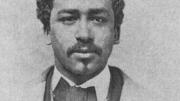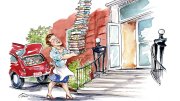In an astonishing find, Rufus McDonald, a member of a clean-out crew preparing a house outside Chicago for demolition in 2009, discovered a steamer trunk of papers and documents collected by Richard Greener, A.B. 1870, the first black student to graduate from Harvard College. This find has recently come to light and now Harvard and other institutions are interested in acquiring the papers. Historians believed Greener’s papers had been lost in the 1906 San Francisco earthquake, as he had passed through that city at the time. Instead, he apparently kept his personal dossier, including his Harvard diploma, with him in Chicago, where he lived during his last years.
Greener (1844-1922) left school at 14 to help support his mother; in Boston he worked in wood engraving and as a porter, and found time to read during duty as a night watchman. Through sheer determination, he prepared himself for Harvard at Oberlin and Andover, and matriculated in 1865 as a 21-year-old freshman. He won two Bowdoin prizes as an undergraduate.
A few years after college, Greener became a professor of philosophy at the University of South Carolina and was also able to study law there, winning his law degree in 1876 and admission to the bar of the District of Columbia two years later. Before long, Greener became dean of the department of law at Howard University. He knew African-American leaders of the era like Booker T. Washington and Frederick Douglass. Fletcher University Professor Henry Louis Gates Jr. has described Greener as “a leading intellectual of the time.”
Greener went on to work in government jobs in Washington and had numerous contacts with President Ulysses S. Grant. He was active in Republican politics and in 1885 was appointed secretary of the Grant Memorial Association in New York State. In the late 1880s he turned to literary work and served as associate editor of the National Encyclopedia of American Biography. In one 1894 essay, he reframed the “Negro Problem” as “The White Problem.”
In 1898, President McKinley appointed him U.S. commercial agent at Vladivostok in Siberia. Greener left his American family and took a Japanese common-law wife, with whom he had three children. He retired from the Foreign Service in 1905, and lived with cousins in Chicago from 1909 until his death in 1922.
One of Greener’s daughters by his first wife changed her name after her parents separated; styling herself Belle da Costa Greene, she became a linchpin of the Morgan Library in New York City, working directly with J.P. Morgan. An expert on medieval illuminated manuscripts who became Bernard Berenson’s mistress, Greene traveled extensively in Europe, acquiring objects for the Morgan collection. She and Berenson, A.B. 1887, remained friends until her death in 1950. A woman of notable beauty and intellect who never married or had children, she passed as white for most of her adult life, which she spent among the aristocracy of New York society. Hundreds of her letters to Berenson repose in the library of Villa I Tatti, Berenson’s former estate and now Harvard’s Center for Italian Renaissance studies in Florence.
Playwright Juliane Hiam, author of a 2010 one-act play, Belle of the Books, about da Costa Greene, says the underlying theme of her work is “the pain Belle may have felt from losing her relationship with her father. Passing as white required her to turn her back on her roots.” As “Belle destroyed all her own papers,” she adds, “the discovery of papers by anyone connected to her is really exciting. Someone like me would hope that the found documents would contain some clue as to the nature of their estranged relationship.”
Updated 2/22/18: The link in the first paragraph of this post originally led to an article by Kim Janssen in The Chicago Sun-Times, published on March 11, 2012. Because that article is no longer freely accessible online, a new article that provides additional information has been substituted.









